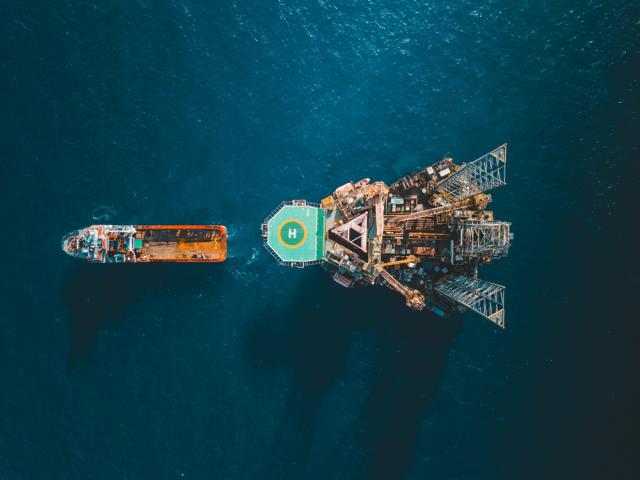
Calculating emissions for offshore service vessels is no easy task. (Source: Shutterstock)
With Texas trapped under a heat dome, Death Valley pushing 130 F and entire regions of the globe stuck in what feels like an outdoor air fryer, emissions have taken on added significance this summer.
Baked into many minds is the need to decarbonize—a goal since the Paris Agreement was finalized in 2015.
On land, oil and gas producers have upped their efforts—and reporting—on cutting emissions. But one part of the sector remains especially tricky to get a handle on: offshore energy.
With a number of paths to net zero carbon, curbing offshore emissions would be a big win, but just getting on top of how much CO2 is being emitted is no easy task.
“I have definitely seen a dedication across the market to trying to improve emissions performance in the offshore market, but it is much less structured than you see in the marine market, where you have very clearly defined metrics and goals that are defined” by the International Maritime Organization, or IMO, Matt Tremblay, ABS vice president of global offshore, told Hart Energy.

For the marine market, the language of emissions is termed as carbon emitted per ton-mile of cargo. Measurements including the Carbon Intensity Indicator (CII) and Energy Efficient Existing Ship Index (EEXI) were introduced to track and reduce the greenhouse gas emissions of ships.
The offshore market is completely different, Tremblay said, as offshore service vessels (OSVs) and platform supply vessels (PSVs) aren’t actually transporting cargo. Calculating emissions for those vessels is a whole different ballgame.
Consider two identical drilling vessels, Tremblay said. “If the subsea well that they're drilling is different—if one is a harder formation or an easier formation—the emissions could be different based on how much CO2 is permitted per foot of subsea well drilled,” he said.
The same goes for an OSV with an identical sister vessel.
“One is doing one long run to a drilling rig that's far offshore and then all the way back to shore to resupply—while its sister vessel may be going to one rig, to one rig, to one rig and then back to shore,” Tremblay said. “It's really hard to define one simple or even complicated algorithm that can apply to everything in offshore.”
Even with the difficulties in defining an acceptable level of emissions, the offshore industry is mindful of reducing the amount of CO2 being produced by their vessels. Simply slowing a ship is the most common way that shipping companies lower their emissions offshore, as driving slower emits less CO2 per ton-mile of cargo carried. Going faster costs more fuel.
Another relatively simple way to curb carbon emissions is by installing scrubbers in the exhaust system of the ship. Scrubbers control pollution by removing particulate matter and harmful components from the exhaust gasses that are generated by combustion marine engines.
Hybrid batteries is another, more technologically complex way for offshore vessels to reduce emissions. According to Tremblay, one OSV company retrofitted 10 units in their fleet with hybrid batteries. Giving the vessels both battery power and diesel engines, the company has reported between 20% and 30% fuel savings across their fleet.
Vessels are now able to take advantage of closed bus operations while in dynamic positioning mode, at which time they use their thrusters to maintain position.
“One of the means of operating those vessels more efficiently is by using what we call ‘closed bus operations,’ meaning there's a circular electrical bus that distributes the power throughout the users of power on board,” he said.
In the past, closed bus operations weren’t permitted during dynamic positioning mode because a failure could cause an entire power system to go out “and therefore you would lose position,” Tremblay said. “There's been new technology developed by companies like Siemens and others that have figured out how to allow these systems to operate in that closed bus mode while preventing failure that would cause a shutdown.”
Even though it is tougher to calculate, it is not impossible for Tremblay to imagine a future where the offshore market is like the marine industry. That will mean having the ability to define an acceptable level of performance for offshore vessels despite different operating criteria.
Tremblay said he’s beginning to see companies show improvement by setting aggressive emissions targets.
“We are seeing the first instance of targets being set in the EU through an initiative the EU is putting together called Fit for 55, where all vessels, including offshore vessels that enter EU ports after its implementation date, are going to have to show a certain level of emissions reductions,” he said.
The road to net zero has been a long journey, and offshore’s course may be even tougher to chart. But Tremblay is confident in the mission, saying it will require a “number of technologies, some of which we probably haven't discovered yet.” Alternative fuels such as methanol, hydrogen and ammonia could be options in the future, as they all emit less CO2 than standard diesel fuel. Unfortunately, for an alternative fuel to become widely accepted, it must be “affordable and abundant” and at this point, the technologies are not there yet, Tremblay said.
“The marine industry has pretty well-established standards developed by IMO. The offshore industry really doesn't. What's driving the improvement in the offshore industry is based on internal ESG policy and policy from the financiers,” Tremblay said. “The challenge in front of us is going to require a number of different technologies. We’ve got a 50-year problem in front of us that we’re going to be solving for a long time.”
Recommended Reading
E&P Highlights: Feb. 3, 2025
2025-02-03 - Here’s a roundup of the latest E&P headlines, from a forecast of rising global land rig activity to new contracts.
E&P Highlights: Jan. 13, 2025
2025-01-13 - Here’s a roundup of the latest E&P headlines, including Chevron starting production from a platform in the Gulf of Mexico and several new products for pipelines.
E&P Highlights: March 10, 2025
2025-03-10 - Here’s a roundup of the latest E&P headlines, from a new discovery by Equinor to several new technology announcements.
E&P Highlights: Jan. 21, 2025
2025-01-21 - Here’s a roundup of the latest E&P headlines, with Flowserve getting a contract from ADNOC and a couple of offshore oil and gas discoveries.
E&P Highlights: Feb. 18, 2025
2025-02-18 - Here’s a roundup of the latest E&P headlines, from new activity in the Búzios field offshore Brazil to new production in the Mediterranean.
Comments
Add new comment
This conversation is moderated according to Hart Energy community rules. Please read the rules before joining the discussion. If you’re experiencing any technical problems, please contact our customer care team.




